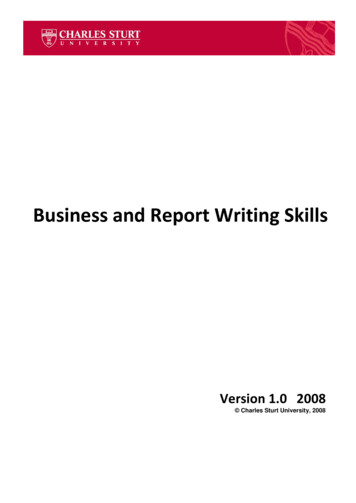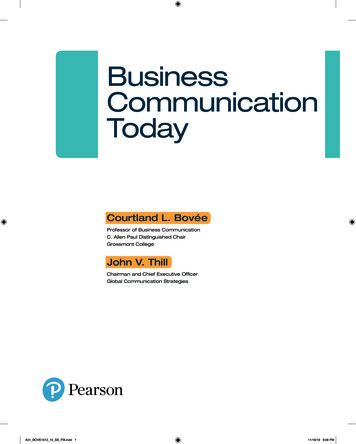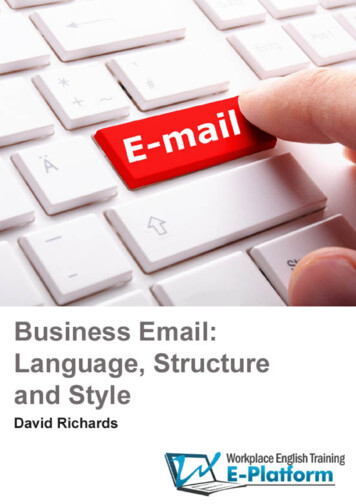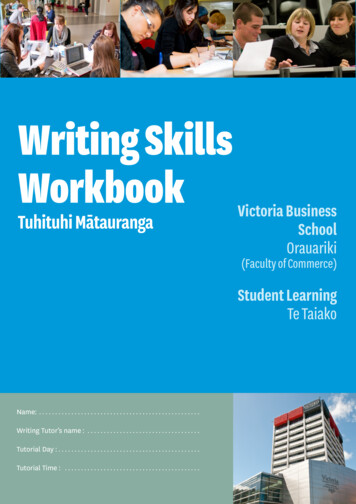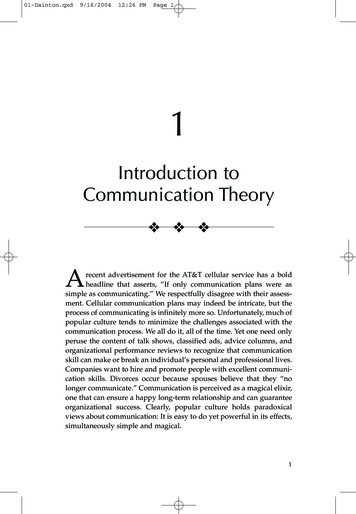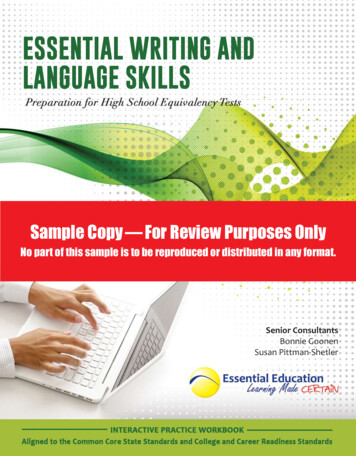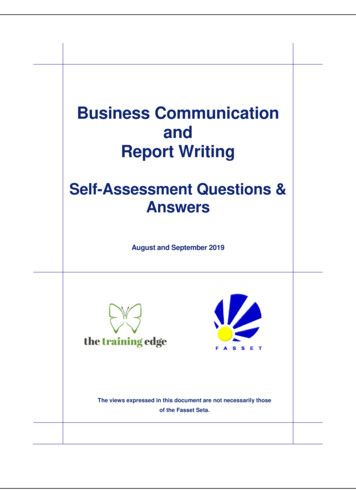
Transcription
Business CommunicationandReport WritingSelf-Assessment Questions &AnswersAugust and September 2019The views expressed in this document are not necessarily thoseof the Fasset Seta.
Business Communication and Report WritingAugust & September 2019UNIT 1: INTRODUCTIONQuestion 1Define business communication.Answer (See p2 of the handbook)Business communication is the sharing of information between people within an enterprise that isperformed for the commercial benefit of the organisation. In addition, business communication canalso refer to how a company shares information to promote its product or services to potentialconsumers.Question 2Give at least 3 reasons why effective business communication is important in business.Answer (See p3 of the handbook) Promotes motivationEffective communication can motivate employees and create a sense of engagement and belonging,through the healthy flow of information. Increases productivityThe success of any project is dependent upon the ability of employees to communicate andcollaborate as a successful team. Effective communication promotes understanding and builds trustbetween employees. Helps to grow customer baseCustomers are without a doubt, the lifeblood of the business. Businesses rely on customers forsurvival. Effective external communication can help attract new customers and retain existing ones. Improves Business Partnerships/RelationshipsAnother important aspect of effective communication is improved partnerships and businessrelationships. Communication is crucial when dealing with suppliers and external business contacts.Sometimes suppliers need to be regularly updated on all products and processes to ensure a smoothflow in the value chain.2
Business Communication and Report WritingAugust & September 2019Question 3At work, we communicate in a variety of written formats and for a variety of reasons. What are the mostcommon reasons?Answer (See p4 of the handbook) To correspond (Memos, letters, emails, SMS etc.) To record and document (Minutes of meetings, notices, registers, agendas etc.) To propose (Research proposals, business proposals, funding proposals etc.) To plan for action (Strategic plans, project plans, action plans etc.) To report on facts about a specific business matter (Product analysis, project report,feasibility study, research report, evaluation report etc.)Question 4Create your own definition of a business report.Answer (See p4 of the handbook)A combination of the following elements of a definition: A business report is an orderly, objective communication of factual information that servessome business purpose. (Lashkar & Petit) A business report is an impartial, objective, planned presentation of a fact to one or morepersons for a specific, significant business purpose.” (Murphy & Hildebrandt) A formal communication written for a specific purpose that includes a description ofprocedures followed for collection and analysis of data, their significance, the conclusionsdrawn from them and the recommendations, if required. (Sharma & Mohan) A business report can be defined as an organised, written statement of facts related to aspecific business matter. It helps the interested persons to get insight into the problem andassists in decision-making and problem-solving.3
Business Communication and Report WritingAugust & September 2019Question 5Why are business reports written in the past tense?Answer (See p6 of the handbook)In most of the cases, reports are written on past events. Most business reports carry the reasons forincidents, the ways of recovery etc. Therefore, reports are also written in past forms/tense.Question 6Name 3 characteristics of business reports.Answer (See p6 of the handbook) Specific IssueBusiness reports are written on a specific subject. They are written to fullfil a certain need. Pre-Specified AudienceAn important characteristic of a business report is that it has a specified audience. Usually a reportis written for a limited number of audiences and the needs of the audience are always kept in mind. Specific Structure or LayoutIn preparing reports, certain structures/layouts/formats are followed. Written on Past EventsIn most of the cases, reports are written on past events. Most business reports carry the reasons forincidents, the ways of recovery etc. Reports are also written in past forms/tense. Neutral in NatureIn drafting reports, strict impartiality must be maintained. No biased or non-objective material isincluded. Biased reports may lead to disastrous decisions. Factual InformationBusiness reports are always written based on factual information. The data collected on specificevents is factual, not factious. Joint EffortSometimes business reports are an outcome of joint efforts of a group of people – where a committeeis formed (3 to 7 people) to furnish a report on a certain incident.4
Business Communication and Report WritingAugust & September 2019Question 7What are the three stages of report writing?Answer (See p7 of the handbook)Planning, writing, revising5
Business Communication and Report WritingAugust & September 2019Unit 2: PLANNINGQuestion 8What are the 4 steps in planning?Answer (See p8 of the handbook) Define the purpose and scope of the report Consider the audience Gather information for the report Design the structure of the reportQuestion 9Explain 3 purposes of writing business reports (reasons for writing reports).Answer (See p9 of the handbook)The purpose of the report could be to share an idea, answer a question, solve a problem, or shareinformation.Question 10Why is it so important to consider your audience when planning to write a business report?Answer (See p10 of the handbook) An important aspect of report writing is to consider your audience. Unlike letters and memos - reports and proposals have a far wider distribution. Readers of your report may be involved in the problem-solving or decision-making process,so your job is to make it easy for them to understand the information and data presented. In order to make reading the report easier, think in terms of the reader.Question 11Explain what is meant by primary audience.Answer (See p10 of the handbook)People who must act or make decisions based on the document6
Business Communication and Report WritingAugust & September 2019Question 12Explain what you want to know about your primary audience that will impact on the focus and scope ofthe report?Answer (See p11 of the handbook) What do they expect to learn from the report? What do they already know? What don’t they know that must be included in the report? Do they hold certain biases or preferences that will impact on the interpretation of the report– and hence decision-making or problem-solving? What positions do they hold in the organisation? What are their levels of education / work experience relevant to the report? What decision making powers do they have relevant to the report?Question 13Discuss the criteria you consider when gathering information for the report.Answer (See p13 of the handbook) Ensure that what you gather is accurate Make sure that personal bias isn’t skewing the evidence by letting how you feel get in theway of what you gather Be selective about what goes into your report. Consider your audience Gather evidence based on careful observation, interviews and research For credibility and authority, use a certain amount of secondary data, obtained in print orelectronically.7
Business Communication and Report WritingAugust & September 2019Question 14What must you consider when planning to gather information for business reports?Answer (See p14 of the handbook)Consider the following pointers when planning to gather information for business reports: What information do you want to gather? How will you gather the information, i.e. observation, documentary review, interviews, etc.? What sources will you gather data from? From whom or where? How will you analyse and interpret the information you have gathered?Question 15What are the 4 different formats you can use to structure business reports?Answer (See p15 of the handbook) Memorandum report Letter report Short report Formal reportQuestion 16When would you choose a memorandum format report?Answer (See p15 of the handbook)It is helpful as a short report about internal matters, and is not sent to anyone outside the company.A memorandum report can be helpful for reporting on internal sales figures, letting a manager knowhow the team has performed during the week, or to provide an interim update on an inventory.8
Business Communication and Report WritingAugust & September 2019Question 17Prepare the outline structure of a short report relevant to your work.Answer (See p16 of the handbook) Details provided in the following clusionTables and graphics ifrelevantRecommendationsTitle pagePreliminary summary(including conclusion &recommendationsAuthorisation detailsStatement of theproblem9
Business Communication and Report WritingAugust & September 2019UNIT 3: WRITINGQuestion 18What are the tips and techniques to good report writing – the 4 C’s?Answer (See p22 of the handbook)With the proper attitude, a respect for how words work together and knowledge of usage conventions,your writing can be clear, concise, complete, correct and easy to read.Question 19Look at the following list. Which words would your audience be more familiar lOptionChoiceAnswer (See p25 of the handbook) Guess Monitor Working ChoiceQuestion 20Rewrite this sentence to be more precise: “There is an increase in our sales.”Answer (See p25 of the handbook) There is a 10% increase in our sales.10
Business Communication and Report WritingAugust & September 2019Question 21When is it appropriate to use jargon in your report?Answer (See p26 of the handbook)It would only be appropriate to include jargon when you are writing to someone who you know willnot only understand, but expect you to use, that jargon.Question 22Rewrite this sentence to be more clear: “Arriving late for my exam, the exam venue was closed and Iwas shut out unable to take the test.”Answer (See p27 of the handbook) I arrived late for my exam and was unable to take the test.Question 23Rewrite this sentence to remove unnecessary adverbs: “The service was much more efficient thanbefore.”Answer (See p28 of the handbook) The service was more efficient than beforeQuestion 24Why must you not rely on clichés and metaphors when writing reports?Answer (See p28 of the handbook)When we speak with friends, our language can become full of words that don’t belong in businesswriting. Try to avoid relying on clichés and metaphors to get your meaning across. Replace thosephrases with words you really mean, and that other people will understand more easily.11
Business Communication and Report WritingAugust & September 2019Question 25Explain at least four techniques to make your message morecomplete.Answer (See p30 of the handbook)Writing is complete is when all the information needed, for a receiver to understand, is included.While the writing situation and knowing your audience will help you decide what information toinclude, you can also refer to the following list: Use the 5 W's and an H. Answer the questions: Who? What? Where? When? Why?How? Make a checklist of all the important points you want to cover, and then check them offwhen the report is done. Empathise with the reader. Ask yourself if you have told them everything they need toknow. Restate for effectiveness. You will state the problem or objective clearly at the beginningof your writing, so that your reader understands what is important. Since readers are mostlikely to remember what is at the beginning and at the end, you will need to restate it usingslightly different wording to add emphasis. Give something extra when appropriate, such as an example, a visual or a supportingreference.Question 26Name 3 different characteristics between active and passive voices in writing.Answer (See p31 of the handbook)ActivePassiveIs direct (The manager pressed the buttonon the photocopier.)Is indirect (The button on the photocopierwas pressed by the manager.)Reduces lengthReverses the normal subject-verb-objectpatternClarifies the sentenceIncludes some form of the verb, followedby a past participle (was pressed)Produces a crisper, more vital styleUsually considered weak, obscure, wordyand lacking vigour12
Business Communication and Report WritingAugust & September 2019UNIT 4: REVISINGQuestion 27Explain at least 5 principles for good proofreading.Answer (See p38 of the handbook) Read through once and ignore content. As soon as you start paying attention to what thetext is saying, you'll start assuming what the words are and stop looking for errors. Assume there's at least one error, so that you have something to find. Forget what you meant to say. Read the report as though you have never seen it before. Read backwards. This destroys comprehension, and your eyes can't trick you as easily. Don't try to do something else when you proofread. Stop tinkering with it and rewritingsentences; look for errors. Take your time. When you hurry, you guess and skim, and that usually doesn't work. Proofread a second time, paying attention to content. This is where you find those thingsspell check and reading backwards did not catch, such as, “The little cap pulls off it you putenough effort into it.” Leave it alone overnight, so that you come to it again having fresh eyes to look at it. Read it aloud. It is more difficult for your eyes to skip over errors when you read aloud,because you will hear something out of whack. Try to have someone else proofread your work, particularly if the document is important orgoing to be released to the public.Question 28When you do a quality check of your report to ensure it meets the four C’s, what are you checking for?Answer (See p39 of the handbook)Do a quality check of your report to make sure that it meets the four C’s. Your report is clear if it is fully understood at first reading. By concise, we mean that all information is down to an intelligent and intelligible minimum. Your report is complete when every piece of essential information has been included. Finally, your report is correct when all information is both accurate and verifiable.13
Business Communication and Report Writing August & September 2019 2 UNIT 1: INTRODUCTION Question 1 Define business communication. Answer (See p2 of the handbook) Business communication is the sharing of information between people within an enterprise that is
